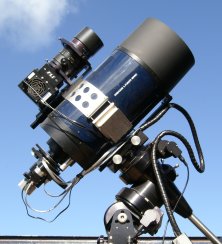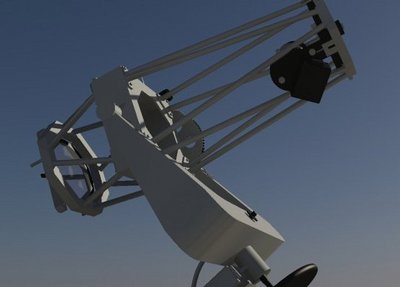
The research of this group, led by Martin Jelinek, includes studies of energetic galactic and extragalactic cosmic sources with energies ranging from the far UV through the visible, X-rays and into the Y-ray band. The targets of its activities are the multi-spectral analysis of gamma-ray bursts (GRB) and their optical afterglow, active galactic nuclei (AGN), especially blazers, and other types of high-energy celestial sources, including various types of X-ray binaries and cataclysmic variables (CV).
 |
| BART robotic telescope |
 |
| D50 robotic telescope |
To obtain the necessary high-energy observational data, the group has been involved in high-energy satellite research and also collaborates with a future ground-based facility dedicated to gamma-ray observations from the surface – the Cherenkov Telescope Array (CTA), which is being built at two sites on La Palma and Paranal. CTA now includes three robotic telescopes built and operated by FRAM in collaboration between the Institute of Physics and the High Energy Astrophysics Group.
The group operates two relatively small robotic telescopes on the ground of the Ondřejov Observatory. The BART robotic telescope with a diameter of 25 cm and the D50 robotic telescope with a diameter of 50 cm. The role of these telescopes is to complement high energy with original optical data for both GRBs and CVs. These objectives complement each other well, as GRBs require a small amount of rapid response time, while CVs occupy the long term programme. These two telescopes are part of the GLORIA network.
The members of the group are also involved in the European Space Agency’s INTEGRAL, Gaia and XEUS projects, as well as with NASA in the Constellation X study, in particular for the detection of cosmic ray bursts (BART, D50, BOOTES experiments). Other data are obtained from astronomical plate archives – periods of up to 100 years, which provide valuable information on the long-term behaviour of resources in the optical field.
The members of the group regularly organise international conferences and workshops, such as the International workshops on Astronomical X–Ray Optics (AXRO) and the INTEGRAL/BART workshops (IBWS), and participate in the organisation of large international conferences, such as SPIE Europe, the Frascati Workshop on Multispectral Behaviour of Cosmic High-energy Sources, and the International Conferences on Frontier Objects in Astrophysics.
Members of the group
- Researchers: Martin Jelínek (head), René Hudec, Vojtěch Šimon
- External researcher: Christina C. Thoene
More info
- Web sites of the group: http://altamira.asu.cas.cz/
- Observation of gamma-ray bursts: FRAM GRB triggered observation
- Observation of gamma-ray bursts: D50 GRB triggered observation
